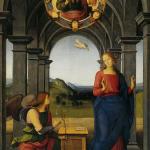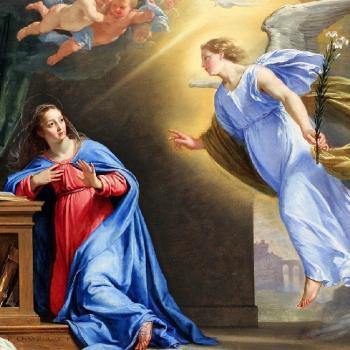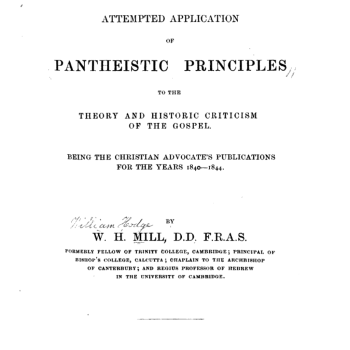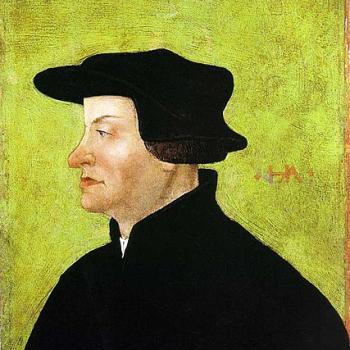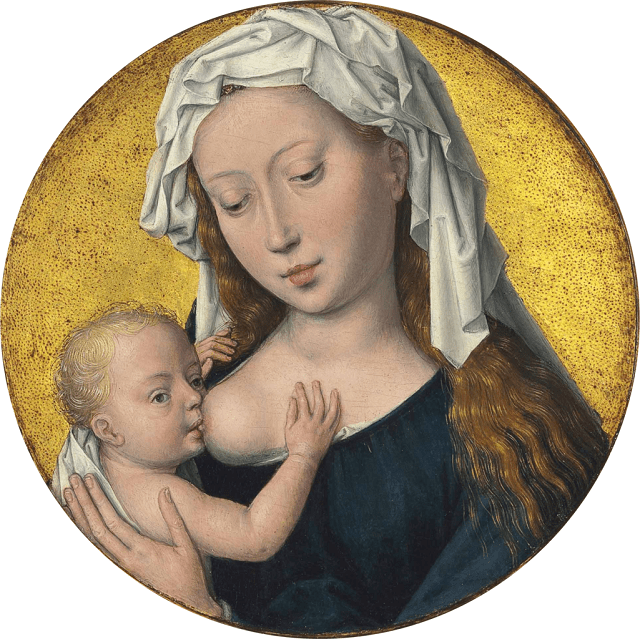
Words of Fr. Deacon Daniel G. Dozier will be in blue; those of Pete Vere in green. Both are Eastern Catholics. This took place on my Facebook page.
*****
So you want to argue in favor of a nude Icon of the Madonna?
I don’t. I personally don’t care for them. But that’s not the point at all, which is: were these statues consciously, idolatrously, blasphemously adored as gods (with the sanction of the pope and the Vatican), or were they not? There is no evidence that they were; therefore, the charge that this happened is gravely sinful.
I’m taking issue with the fact that if they are going to assert that these things plucked from its pagan are or can be legitimate “icons” of the Blessed Virgin Mary. Gospel inculturation is more than just taking statues of Apollo and calling it Christ. The image must also teach and be imbued with Christian symbolism so that it clearly is the Virgin Mary. Had this image been clothed and adorned with the language of Christian symbolism associated with the Theotokos, I do not think you would have any real outrage. But this is not a legitimate Christian icon and they are referring to it by its pagan title. This is a problem of their own making.
I know that this is your issue, but it’s not mine or what the bottom-line issue of the whole thing is. It’s not iconography, but rather, whether what happened was idolatry. That is what these people and the pope are being accused of; yet the accusers have never honestly examined all of the relevant evidence.
People don’t care about facts. We’re in a postmodern world now where they simply don’t matter. Everything is feelings, subjectivism, and emotion, leading to divisions and polarized tribes within the Church. When everything is subjective, honest differences can’t possibly be resolved, and so we are left with relentless suspicions and rumormongering.
But I think it is relevant to your main point. I can argue that by worshipping an idol of Zeus which I refer to as Zeus I am actually worshipping God the Father all I want, but in my words and deeds it just looks like I am worshipping Zeus. This is a problem of their own making, which was entirely avoidable.
Nope; it is a problem ultimately brought about by the unwillingness of the critics to examine what was going on, and to understand how a different culture expresses itself in Catholic worship.
Where I do agree is in criticizing the Vatican for not making a serious effort to explain what would inevitably be misunderstood (and was). There is a hostility to non-European piety that is deep enough that (in my opinion) what happened should have been anticipated and decisively dealt with, to avoid this debacle that we now have.
It should have been known that a significant sub-group of Catholics (reactionaries) have basically a Protestant and liberal Catholic outlook. So they make the accusation of idolatry without serious reason to, just as Luther and Calvin did in the 16th century.
See and I think you are being too generous to the Vatican organizers of the Amazonian Synod that was neither Amazonian nor a Synod. The problem is not with the reactionaries. The problem is that they (the organizers) do not understand Christian iconography.
I can grant that point (your last sentence; not that the reactionaries have no fault), but it is a relatively minor one in the whole controversy. “What is a proper icon?” is a legitimate concern, of course, but it is far from (and far less serious than) the question of “did rank idolatry and worship of a false god consciously occur, with the pope’s approval?”
The latter is what all these reactionaries are discussing; it is the controversy, and it’s why I as an apologist have devoted so much effort to it. Your concern is only a small secondary point, in terms of what they are concerned about.
In my own articles on the topic, I’m simply not dealing with iconography, Catholic aesthetics, and liturgical considerations, but with the question of whether the pope and the Vatican sanctioned idolatry in a way that would be outrageous, blasphemous, and heretical. There is no evidence that they did that, which in turn makes the repeated public charges even more ludicrous and outlandish and gravely sinful.
I think by their silence they sanctioned an unhelpful murkiness under the guise of inculturation, which is pretty irresponsible. I see my point as the central one that upends both the points of the reactionaries and the Vatican’s defense of their actions.
The reactionaries were reacting to the easily misunderstood actions of others (as I demonstrate above with my Zeus reference).
Let me see if I understand you correctly:
As best I can tell, you are contending that the statues were so far removed from the past history of iconography of the Blessed Virgin Mary, that this irresponsibility of the Vatican 1) allowing it at all, in light of this past history, and 2) not properly and helpfully explaining when controversy arose, is indeed the heart and origin of the whole controversy, and caused the reactionaries to understandably (though wrongly) charge idolatry, when there was in fact (?) none intended.
I don’t know what you think about what the practitioners intended, or if you thought idolatry took place regardless of their intentions (hence, my question mark).
***
Assuming the above is an accurate summary of your argument, where I would disagree is:
1) “they are referring to it [the statue] by its pagan title.”
The people themselves did not do so. They called it “our Lady of the Amazon.” The Vatican clarified the pope’s reference to “pachamamas”, but of course, the reactionaries never care about any clarification, which they instantly interpret in a cynical, doubting way. Other statements from the Vatican were conflicting and contradictory. But what we seem to know from the people in the ceremony is that the statues were NOT “pachamama” [which is not even an Amazonian phenomenon] and did represent the Blessed Virgin and/or “mother earth” (perhaps it can have a double application).
2) “it just looks like I am worshipping Zeus.”
This is a huge question. To our European Catholic (and Orthodox, and also Protestant-influenced) eyes, filled with the memories and continuing practice of 2000 years of European iconography, these statues look weird and even bizarre and thus we may instantly conclude that they must be idols. But who’s to say that vastly different non-European forms of Marian piety are not equally valid and proper and pious? Why should European art be the only standard for what is proper and pious and what is not?
In other words, there could indeed be at the very least, a bias in what such an icon “should” look like, and at worst, in some cases, actual prejudice against other Catholic cultures, because we personally don’t care for their own brand of icons and they are utterly “foreign” to us. So it “looks” like worship of an idol, because we can’t fathom a pious expression of Marian veneration with regard to a statue that we find repulsive and ugly and offensive.
A couple of thoughts. Yes, for the most part what you are saying reflects my thoughts, although I cannot say for certain that idolatrous worship was not interspersed in some of the liturgies at the Vatican, since, while I do not think they were deliberate on the Pope’s part, I think we witnessed some very strange ceremonies, including some that were led by the Franciscans. And it would be helpful of course if we had the actual texts that were used. I did not think the primary issue is a cultural one regarding the imagery. I have seen many images that were the Virgin Mary presented according to some of the artistic standards of indigenous people. What I saw was an attempt to truly integrate culture and faith, and there was some attempt at least to retain some core Christian symbolism. I really don’t see any of that in this particular case. Gospel inculturation needs to be more than just appropriation. There should at least be some effort made to ensure that the image is reflective of the received Christian tradition. I cannot simply bring a Statue of Liberty statuette to the Vatican and hand it to the Pope and say “This is Our Lady of the United States.” Icons especially should avoid all manner of ambiguity regarding their identity. It should be clear who the sacred person is. The Pachamama images are radically unclear to any Christian familiar with even a basic level of familiarity with Christian iconography.
So the problem is with the ambiguity of the image, it’s incorporation into strange and unfamiliar non-traditional rituals, and the employment of the Pachamama deity name in describing it, even in italics.
I think it depends what means by iconography. If we are going with the Byzantine understanding, or even the Coptic/Alexandrian understanding, then the Pachamama carvings are not icons since our Eastern grammar when it comes to iconography is quite strict.
So strict, in fact, that much of Western sacred art also would not qualify as iconography.
As far as repurposing a Zeus statue as God the Father… For all intents and purposes, isn’t this what Michelangelo did with his famous statue of King David? Basically he removed the wings from Apollo’s heels. [link to image]
Additionally, Father Deacon Daniel, whereas we in the East–especially in Byzantium–have for the most part rejected portrayals of God the Father in our traditional iconography (with the exception of Rublev’s Trinity), Latins have never been as strict in their sacred art tradition.
Thus western sacred art has often portrayed God the Father in Zeus-like images and poses. Again, looking at Michelangelo, there’s his famous “Creation of Adam” painting in the Sistine Chapel that features God the Father in a very Zeus or Jupiter-like pose. [link to image]
In short, Deacon Daniel, I do not disagree with you that the Pachamama does not meet the strict grammar of traditional Eastern Christian iconography. But neither does not much of the western sacred art tradition.
Another famous piece by Michelangelo is the Pieta, which denies us communion with Christ according to our Byzantine grammar because the statue does not allow one to look into Our Lord’s eyes.
As you are well aware, but many of our Latin brothers and sisters following this discussion may not be, the reason saints are portrayed either in full-face or three-quarter profile in Byzantine iconography is so that both eyes are visible. This is because communion comes through the eyes.
Thus the traditional image of Our Lady of Guadalupe does not meet the traditional Byzantine standard since it often portrays the Blessed Mother with her eyes closed.
We would also have to reject traditional western images of Our Lady of Lourdes and Our Lady of Fatima, as well as the ubiquitous miraculous medal, since they portray the Blessed Theotokos without Christ embracing her or enthroned on her lap.
And given that we both live in North America, this traditional western image of the North American martyrs would also have to be jettisoned since it portrays two of the martyrs in side profile–which in traditional Byzantine iconography is reserved for Satan or Judas.
In short, Pachamama clearly is not Byzantine or Eastern iconography. That does not mean it cannot be repurposed within a Latin context. As noted above, Michelangelo has already repurposed Zeus for God the Father, and Apollo for King David.
Thank you, Pete. I would only say that, while King David is a sacred figure, would anyone really argue that Michelangelo’s King David, while artistic, constitutes liturgical art? I mean, it is certainly historic, but is it an object of sacred veneration, devotion and prayer? Not in the least.
I’m saying that sacred iconography is as much a matter of pedagogy and prayer, as it is cultural appropriation. And I see almost no pedagogy here.
Very interesting argument and input, Pete. Thanks. I was mainly noting that non-European Christians art may be very different, and who is to ultimately say that this is legitimate or not?
Would anything not two-dimensional be immediately disqualified as an icon, from the Eastern perspective?
I would actually love to see some artist/iconographer attempt to Christianize the image drawing on some common aspects of Eastern or Western tradition.
My apologies for not answering your question directly, but using some qualifiers to limit the question. The reason being my expertise is mainly in Byzantine iconography and does not extend to all Eastern Patrimonial Traditions. So while I can answer generally for the Byzantines, I am not familiar enough with Coptic, Armenian, or other Eastern Traditions to give an informed answer according to their iconology.
So according to the Byzantine tradition, icons are “two dimensional” because they represent how God sees us and not how we see ourselves. So it is God’s view from Eternity. This is also why various icons will show the same person or event from different perspectives, or different events that are related. Because God’s perspective is not limited by time and space.
The one exception is the Icon of Christ Sinai, the original which is I believe the oldest surviving icon of Christ in the world. Half of Christ’s face is two dimensional according to traditional iconography, while the other half is three-dimensional. This is to symbolize Christ’s two natures in one Person.
The wikipedia entry for the icon has some excellent comparisons showing the original icon, plus what each side looks mirrored.
Fr Deacon Daniel – I would say that Michelangelo’s work (including David) is sacred art according to the Latin/Western Tradition, but does not meet the grammar of Eastern iconography. The same is true for much of Latin/Western sacred art.
This past week I was blessed to visit the Basilica of Ste Anne de Beaupre near Quebec City, Canada. It is in my opinion the most beautiful and spiritually inspiring western church in Canada or the United States. It probably the only Western church I would consider equal to Byzantine churches in its spiritual consistency awe-inducing spiritual inspiration.
I’m delighted to see that you believe one western church attains to the Eastern higher standards. :-)
What really struck me was the western iconography in the crypt, as well as the main Basilica. I cannot deny the inspiration of the Holy Spirit over its artists and that it inspires the pilgrim’s vision heavenward.
But on the strict question of whether or not it meets the grammar of Byzantine iconography, the answer is no. As you are well aware, Fr Deacon, being a Byzantine cleric and one whose ministry includes iconography, ours is a very strict grammar in the East–especially Byzantium. The Western iconography and other sacred art at this shrine do not meet our strict standard.
But that does not mean they are in any way wrong, or of no spiritual value, or a danger to the faith. Rather, they inspire within their particular context, which is Latin and Western.
Which brings us to Pachamama. Can it be converted to Byzantine iconography? Like you I have a difficult time seeing it. However, having attended the French Catholic school system as a child, many of my friends and classmates (and some teachers) were Indigenous. Thus I grew up around Indigenous Catholics and the inculturation of Indigenous art forms within local (Latin) Catholic churches.
Pachamama is similar to a wood carving of Madonna & Child that was popular among local Indigenous Catholic artists, and we actually had one in our house that hung next to our Sacred Heart statue. (My father is a Latin deacon). So I am not uncomfortable with the concept within a Western Indigenous Catholic context.
I would agree with you that in the context of Pachamama and statues we are talking Western Sacred Art, and not iconography. It is an important distinction.
What is often not understood by many Latins, Protestants, and even us Easterners is that iconography in the East is much more than sacred art is in the West. It is an entire theology that supports the Eucharist in tying together all other areas of theology. Icons are not just sacred images that inspire our gaze towards Eternity, but an entire language. As Easterners, we “read” icons like you as a Latin apologist would read a Bible commentary.
However, iconology in the West died in the aftermath of the Seventh Ecumenical Council (Second Nicea), which ironically vindicated the use of icons for sacred worship. The reason being the translations from Greek to Latin that ended up in the West were so poor and self-contradictory that Latins and their Frankish-Germanic daughter churches could make neither heads nor tails of them.
For example, one particularly popular but bad translation stated that it was idolatry to use icons in Divine Worship, but to deny their use was Christological heresy. So the West took the attitude that the East seems to have resolved the iconoclasm controversy that had been rocking it for several centuries, and they did not want to risk clarifying these contradictions lest the West accidentally re-ignite this controversy for a fourth time among Easterners.
So the West simply moved on to statues and realism in its sacred art tradition.
I would not argue that King David in this piece is even a form of Western liturgical art. It is certainly artistic and the subject is a sacred person, but it is not a liturgical icon.
That said, I have never argued that Western liturgical iconography needs to follow Eastern canons or practices, although we see that there were common early influences in Rome.
Regarding the Pachamama/Our Lady of the Amazon, I would also here say that it does not need to be Byzantine to be a true icon. But they could at least draw on some patrimony of Christian symbolism regarding the BVM, such as a halo and garments with color schemes that fit with Amazonian culture and their understanding of the sacred. Those simple changes would help clarify the identity of the sacred person being represented here.
Fair enough about Michelangelo’s King David that resembles Apollo. But what about his portrayal of God the Father in the Sistine Chapel that draws upon Zeus imagery from classical Greece? This very definitely is intended as sacred art, even though it draws upon Pagan imagery for artistic influence.
In terms of Pachamama as Our Lady of the Amazon, I think we need to be patient as God is patient and give time to inculturate. I am sure the Indigenous carving of Madonna & Child that became popular among Indigenous Catholics near where I grew up was not the first artistic attempt, but one of multiple attempts that was refined through prayer.
Yeah, that’s a variation of my own argument, except that I broadened it even more, to pointing out that there can be legitimate Catholic traditions in iconography and the larger category of sacred art that go beyond the usual European-dominated theology and spirituality (both Latin and Eastern Catholicism and also Orthodoxy and Protestantism to a lesser extent): to very different approaches from all of those, but still just as Catholic.
I think there was much too much tendency with this whole mess for critics to blithely assume that these statues were (to their eyes and understanding) “ugly” and/or “inappropriate.” But cultural background has a great deal to do with that perception.
Then it is a completely separate discussion, as to whether idolatry was actually taking place. Everything I’ve seen suggests to me that it was definitely not. On the other hand, if someone claims that it was taking place, then the pope participated, since the Vatican sponsored the tree-planting ceremony, and he blessed the statue (which the woman presenting to him called “Our Lady of the Amazon”).
He said there was no idolatry, so to claim otherwise would also essentially amount to calling him a liar.
[cites an article with Cardinal Schönborn saying the ceremony had to do with a “mother of life” archetype] Okaaay… Not seeing any real reference to the BVM. This is more of the same unhelpful ambiguity. If it’s not the BVM, it’s an idol. My point in sharing it was only to say that the ambiguity continues.
It’s very confusing, yet there is no hard evidence that this was idolatry of a pagan goddess. See Dr. Pedro Gabriel’s excellent series of investigative articles:
Paganism in the Vatican? Hermeneutic of suspicion at its peak (Dr. Pedro Gabriel, Where Peter Is, 10-16-19)
But people prefer to listen to biased Catholic media sources: many of them reactionary. The most in-depth, informative articles for the position that no idolatry occurred are by Dr. Pedro Gabriel.
Those aren’t the only choices. It could be a non-idolatrous ceremony having to do with “Mother Earth” (in a Catholic sense that does have a long history, going back to St. Francis and the fathers and positively referenced by Pope St. John Paul II). There is evidence to suggest that even if “Pachamama” was referenced at all, it was in this sense, not a “pagan goddess” sense.
It could be a dual application of Mother Earth and the Blessed Virgin Mary, just as we often see dual applications in Scripture: such as Revelation 12, which references both Mary and the Church.
In the ceremony, they lifted their hands up to heaven, did a deep bow for just a few seconds, and resumed worship of God with hands uplifted. No one was worshiping or adoring any figure present.
I believe it was intended as Mary because of the statement of a woman in the ceremony. But it could also have had to do with “Mother Earth.” Neither thing is necessarily idolatrous. The pope said it was not. That’s good enough for me. For those who dislike Francis, his word is obviously not good enough (nor is the report of the woman in the ceremony).
But it’s simply not the case that it is either the Blessed Virgin Mary or idolatry of a pagan goddess. Vatican and high cleric reports are obviously confused, but this doesn’t prove that idolatry occurred. Cdl. Schönborn gave his opinion. What he holds — consistent with all other opinions from prelates — is that it was not idolatry. That’s what all the interpretations have in common.
Yet people are still out there saying that it was, and not providing adequate reason to do so. The inadequacy of the rationales exists no matter how confused or not able to be perfectly harmonized various people in high places may be.
Yeah, not going there with you, Dave.
*
We eventually got right back to the question of whether idolatry occurred: which has always been my primary concern in all this. If there is still strong suspicion that it did, then (from my perspective) we are at an impasse, and unless people read the best literature on both sides of the question (Dr. Pedro Gabriel on the “no!” side), it will remain an impasse, like so many of the endless debates in the church today (connected to Pope Francis) have.
*
I think it’s very sad and ought not be. We are able to ascertain the facts of the matter, no matter how much the Vatican and a hostile Catholic media have done to assure that unnecessary confusion continues. We’re all orthodox Catholics (little “o”) and should be able to come to agreement, and be able to freely disagree where disagreements are okay and permitted.
*
I cannot accept the idea of venerating “Mother Earth.” The dual symbolism is fine, if interpreted the way you suggest in Revelation 12 with the Virgin Mary as the symbolic embodiment of creation and church.
*
As a Secular Franciscan I’m just fine with the poetry of St Francis and his expression of familial and fraternal relations with creatures altogether worshipping the Lord.
*
“Pachamama” [?] Statues: Marian Veneration or Blasphemous Idolatry? [11-5-19]
“Pachamama” Fiasco: Hysterical Reactionaryism, as Usual [11-8-19]
“Pachamama” Confusion: Fault of Vatican or Catholic Media? [11-12-19]
Anti-“Pachamama” Doc: “Usual Suspect” Reactionaries Sign [11-14-19]
Vatican II –> Alleged “Pachamama” Idolatry, Sez Fanatics [11-15-19]
Bishops Viganò & Schneider Reject Authority of Vatican II [11-22-19]
Viganò, Schneider, Pachamama, & VCII (vs. Janet E. Smith) [11-25-19]
Is “Mother Earth” a Catholic Concept (Church Fathers)? (guest post by Rosemarie Scott) [12-17-19]
“Pachamama” Redux (vs. Peter Kwasniewski & Janet Smith) [12-17-19]
Pope Francis’ Deep Devotion to Mary (Esp. Mary Mediatrix) [12-23-19]
***
***
Photo credit: The Virgin Mary Nursing the Christ Child (bet. 1487-1490), by Hans Memling (c. 1433-1494) [public domain / Wikimedia Commons]
***


